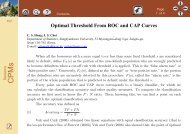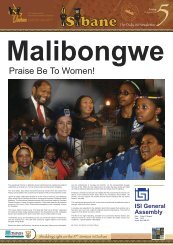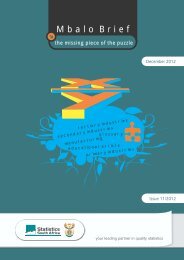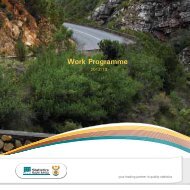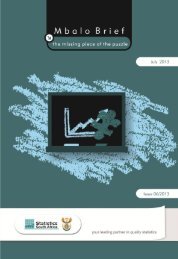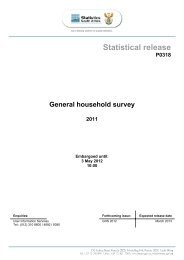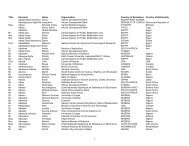Post-enumeration Survey (PES) - Statistics South Africa
Post-enumeration Survey (PES) - Statistics South Africa
Post-enumeration Survey (PES) - Statistics South Africa
You also want an ePaper? Increase the reach of your titles
YUMPU automatically turns print PDFs into web optimized ePapers that Google loves.
<strong>Statistics</strong> <strong>South</strong> <strong>Africa</strong><br />
13<br />
3. DATA COLLECTION<br />
<strong>PES</strong> data collection commenced immediately after the completion of census fieldwork. The <strong>PES</strong> is a<br />
much smaller scale operation (and hence easier to control) than the census. These features enable the<br />
<strong>PES</strong> to deliver a more accurate estimate of the percentage of people and dwellings missed by the<br />
census. <strong>PES</strong> data collection (field operations) was independent from census operations and the<br />
following measures were taken to maintain the operational independence of the <strong>PES</strong>:<br />
• independent listing of <strong>enumeration</strong> areas (EAs) in the <strong>PES</strong> sample;<br />
• using separate/independent office staff in the <strong>PES</strong> and census where possible;<br />
• ensuring the <strong>PES</strong> interviewers were not employed as census field staff in the same area, and vice<br />
versa; and<br />
• maintaining the confidentiality of the <strong>PES</strong> sample so that census field and office staff were not aware<br />
which areas are included in the <strong>PES</strong>.<br />
This chapter summarises the processes that were carried out in preparation for, and during <strong>PES</strong><br />
fieldwork operations.<br />
3.1 Logistical arrangements<br />
Logistical arrangements involved the procurement of fieldwork materials (quantities were based on<br />
sample size and distribution), which included print material (questionnaires, training manuals and<br />
publicity material), field gear, stationery, vehicles and other resources. Once these materials had been<br />
received from service providers, they were stored and packaged into consignments in preparation for<br />
dispatch to the provinces. Training manuals and fieldwork materials, including questionnaires and field<br />
gear, were dispatched to the provinces in preparation for provincial training and data collection by the<br />
courier company. Questionnaires and EA Summary Books were captured on the Census and <strong>Survey</strong><br />
Administration System (CSAS) for tracking purposes.<br />
3.2 Recruitment and training of field staff<br />
For fieldwork purposes, temporary personnel (Fieldworkers and Fieldwork Supervisors) were recruited<br />
from the EAs/districts in which they would be working and underwent rigorous training on fieldwork<br />
procedures to ensure that they deliver work of high quality at the end of the fieldwork phase.<br />
Experienced permanent staff members from Household <strong>Survey</strong>s (based in provincial offices) were<br />
seconded to the project for the duration of data collection in supervisory positions to ensure high-quality<br />
data and minimise costs. These staff members fulfilled the roles of Provincial <strong>Survey</strong> Coordinator,<br />
District <strong>Survey</strong> Coordinator, Quality Assurance Monitor and District Logistics Officer. The reporting<br />
structure for data collection in each province is illustrated in the diagram below:<br />
<strong>Post</strong> Enumeration <strong>Survey</strong> (<strong>PES</strong>)



